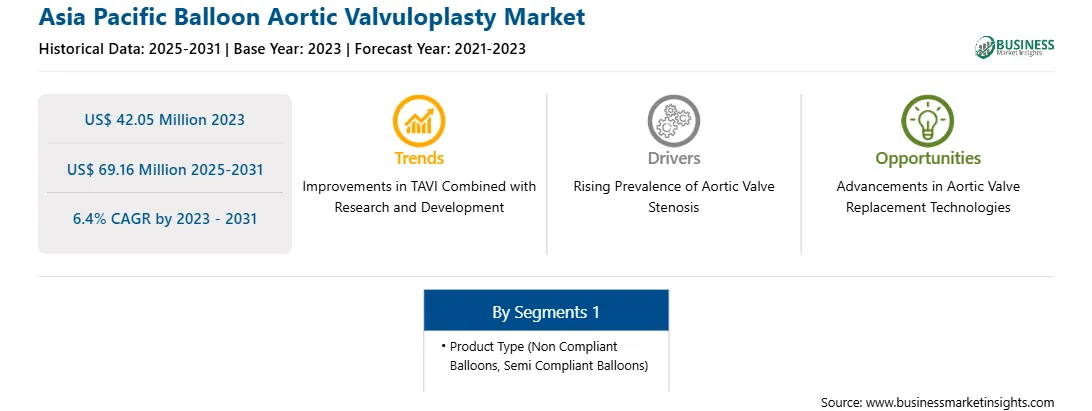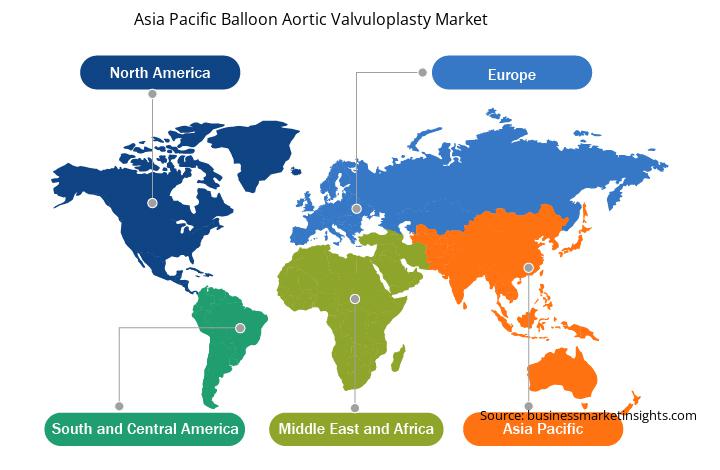The Asia Pacific balloon aortic valvuloplasty market was valued at US$ 42.05 million in 2023 and is expected to reach US$ 69.16 million by 2031; it is estimated to register a CAGR of 6.4% from 2023 to 2031. Rising Prevalence of Aortic Valve Stenosis Drives Asia Pacific Balloon Aortic Valvuloplasty Market
Heart valve disease (HVD) is a cardiac defect increasingly linked to functional decline, especially in aging individuals. HVD can cause stenosis, regurgitation, or a combination of the two in any of the four valves. As the incidence of HVD prominently increases with aging, it is estimated to affect millions globally in the upcoming years.
The narrowing of the aorta can make it difficult for blood to flow from the heart to various parts of the body, resulting in a condition called aortic stenosis. As the heart is under considerable pressure while pumping blood through the constricted aorta, it leads to symptoms such as shortness of breath, chest pain, and fatigue. The high-risk patient populations are inoperable and cannot undergo surgical aortic valve replacement procedures. As per the study titled "Epidemiology of aortic valve stenosis and of aortic valve incompetence (AI)," published in February 2020, a meta-analysis conducted in Europe, the US, and Taiwan found that aortic stenosis had a prevalence rate of 12.4% and severe aortic stenosis reported prevalence rate of 3.4% in patients aged 75 years and over. Aortic stenosis prevalence exponential increases with age, displaying 0.2% in people aged 50-59 years, 1.3% in the 60-69 year group, 3.9% in the 70-79 year group, and 9.8% in people aged 80-89 years. The high prevalence of aortic valve stenosis is surging the demand for balloon aortic valvuloplasty (BAV) devices. BAV is less invasive than conventional open-heart surgery, making it a more attractive option for patients.
The National Echo Database of Australia data 2021 reveals that 97,379 Australians suffered from severe aortic stenosis. The number of moderate to severe aortic stenosis cases in Australia is estimated to grow to 200,000 patients in 2031 and 266,000 by 2051.
Similarly, India is also overburdened with aortic stenosis. The number of fatalities due to calcific aortic valve disease has increased significantly over the past decade in the country. Transcatheter aortic valve implantation (TAVI), also called transcatheter aortic valve replacement (TAVR), has become a well-established therapeutic option for severe aortic stenosis. BAV is a crucial procedural step during TAVI to predilate the valve in order to enhance transcatheter delivery. TAVI has emerged as a ground-breaking, minimally invasive alternative to traditional open-heart surgery, primarily designed for aged patients initially considered unsuitable for surgical intervention due to severe aortic stenosis. Thus, the growing prevalence of aortic valve stenosis worldwide drives the balloon aortic valvuloplasty market growth.Asia Pacific Balloon Aortic Valvuloplasty Market Overview
From a few centers over a decade ago, TAVI is now performed in about 260 centers throughout Northeast Asia, Southeast Asia, and the Indian subcontinent. As the population in Asia advances in age, the demand for TAVI is poised to increase simultaneously. As per a study, "Economic Evaluation of Transcatheter Aortic Valve Replacement Compared to Surgical Aortic Valve Replacement in Chinese Intermediate-Risk Patients," published in May 2022, the prevalence of aortic stenosis was 0.16% in patients younger than 65 years and 0.41% and 0.56% in people aged 65-74 and above 75 years, respectively. According to the study "The current practice of transcatheter aortic valve replacement in China," published in the National Center for Biotechnology Information in August 2022, TAVR device implementation procedures were successful in 97.85% of patients who underwent transcatheter aortic valve replacement procedures in the country in 2022.
According to the Circulation Report from the Official Journal of the Japanese Circulation Society published in 2020, TAVI has been available in Japan since October 2013. The latest guideline on managing valvular heart disease recommends surgical aortic valve replacement (SAVR) for patients aged <75 years and TAVI for patients aged >80 years, regardless of the risks associated with the surgery.
The National Echo Database of Australia data 2021 revealed that 97,379 Australians suffered from severe aortic stenosis. The number of moderate to severe aortic stenosis cases in Australia is estimated to grow to 200,000 patients in 2031 and 266,000 by 2051. The growing prevalence of aortic valve stenosis is surging the demand for balloon aortic valvuloplasty (BAV) devices, as BAV is a minimally invasive procedure utilized to treat aortic valve stenosis. In addition, as stated in the article "Aortic valve replacement rates in Australia from 2004 to 2019," published in PubMed in 2022, about 2,683 TAVI procedures were performed in 2019 in Australia, representing a 52% annual increase from 2014. BAV increased from 66 procedures in 2004 to 862 in 2019. Rates of aortic valve replacements have increased significantly over the past 16 years, especially in older people.
Further, the thriving medical tourism industry in India, China, and Malaysia attracts heart patients worldwide for treatment, facilitating the market growth. Although the cost of medical treatments can be a significant issue for many individuals, it is reassuring that India offers cost-effective TAVI procedures compared to many Western countries. The cost-effectiveness of TAVI in the country does not compromise the quality of care, as the country boasts some of the world's most skilled and experienced cardiac specialists and state-of-the-art medical facilities. As the medical field progresses, India's commitment to providing affordable healthcare options ensures that patients globally can access cutting-edge treatments, including TAVI.
As market players offer more device alternatives due to advancements in technology, access to TAVR procedures will increase significantly. Edwards Lifesciences Corp. received Chinese regulatory approval for the Edwards Sapien 3 TAVR system in June 2020 to treat patients suffering from severe, symptomatic aortic stenosis or are at high risk for developing aortic stenosis or unable to undergo open-heart surgery. The approval marked a significant milestone for the country's physicians and their patients living with severe aortic stenosis in need of alternatives to open-heart surgery. Additionally, in April 2024, Siriraj Hospital, a leading healthcare institution in Thailand, stood at the forefront of aortic valve disease treatment with TAVI. The minimally invasive procedure reduces surgical trauma and post-surgery recovery time when compared to open-heart surgery, providing a viable option for high-risk patients. In 2010, Siriraj Hospital was the first hospital in Thailand to introduce the TAVI procedure for patients who were unable to receive a SAVR. The hospital now provides TAVI as a treatment option for patients with intermediate risks for SAVR and patients aged over 80 years.
In 2021, Peijia Medical, a leading Chinese player in the transcatheter valve therapeutic and neuro-interventional procedural medical device market, launched its second-generation TaurusElite TAVR system after obtaining regulatory approval in China. Additionally, in January 2022, JenaValve Technology, Inc. announced a strategic investment and exclusive technology licensing agreement with Peijia Medical Limited in China. Under the terms of the agreement, Peijia obtained exclusive rights to develop and commercialize JenaValve's Trilogy TAVR system in the Greater China region to treat patients with severe symptomatic aortic regurgitation or symptomatic aortic stenosis. In 2021, the company started clinical trials for its third-generation TAVR system. In July 2023, Peijia Medical enrolled the first Chinese patient in its multicenter clinical trial for these TAVR systems. Apart from the Sapien 3, the Chinese regulatory has approved three locally manufactured valves: the Venus-A valve (Venus MedTech), J-Valve (Jie Cheng Medical Technologies), and MicroPort VitaFlow valve (MicroPort Medical). Two indigenous valves are available in India: MyVal (a balloon-expandable system from Meril Life Sciences Pvt Ltd) and Hydra (a self-expanding system from Vascular Innovations Co Ltd). Thus, the approval of these domestic valves promoted the rapid development of TAVI in both countries. TAVI has emerged as a ground-breaking, minimally invasive choice to traditional open-heart surgery, primarily designed for aged patients who were considered unsuitable for surgical intervention due to severe aortic stenosis.
Asia Pacific Balloon Aortic Valvuloplasty Market Revenue and Forecast to 2031 (US$ Million)
Strategic insights for the Asia Pacific Balloon Aortic Valvuloplasty provides data-driven analysis of the industry landscape, including current trends, key players, and regional nuances. These insights offer actionable recommendations, enabling readers to differentiate themselves from competitors by identifying untapped segments or developing unique value propositions. Leveraging data analytics, these insights help industry players anticipate the market shifts, whether investors, manufacturers, or other stakeholders. A future-oriented perspective is essential, helping stakeholders anticipate market shifts and position themselves for long-term success in this dynamic region. Ultimately, effective strategic insights empower readers to make informed decisions that drive profitability and achieve their business objectives within the market. The geographic scope of the Asia Pacific Balloon Aortic Valvuloplasty refers to the specific areas in which a business operates and competes. Understanding local distinctions, such as diverse consumer preferences (e.g., demand for specific plug types or battery backup durations), varying economic conditions, and regulatory environments, is crucial for tailoring strategies to specific markets. Businesses can expand their reach by identifying underserved areas or adapting their offerings to meet local demands. A clear market focus allows for more effective resource allocation, targeted marketing campaigns, and better positioning against local competitors, ultimately driving growth in those targeted areas.Asia Pacific Balloon Aortic Valvuloplasty Strategic Insights

Asia Pacific Balloon Aortic Valvuloplasty Report Scope
Report Attribute
Details
Market size in 2023
US$ 42.05 Million
Market Size by 2031
US$ 69.16 Million
CAGR (2023 - 2031) 6.4%
Historical Data
2021-2023
Forecast period
2025-2031
Segments Covered
By Product Type
Regions and Countries Covered
Asia Pacific
Market leaders and key company profiles
Asia Pacific Balloon Aortic Valvuloplasty Regional Insights

Asia Pacific Balloon Aortic Valvuloplasty Market Segmentation
The Asia Pacific balloon aortic valvuloplasty market is categorized into product type and country.
Based on product type, the Asia Pacific balloon aortic valvuloplasty market is segmented into non compliant balloons and semi compliant balloons. The non compliant balloons segment held a larger market share in 2023.
By country, the Asia Pacific balloon aortic valvuloplasty market is segmented into China, Japan, India, South Korea, Australia, and the Rest of Asia Pacific. China dominated the Asia Pacific balloon aortic valvuloplasty market share in 2023.
B Braun SE; TT Medical, Inc.; Balton; Becton Dickinson and Co; Edwards Lifesciences Corp; Balt; and Venus MedTech HangZhou Inc are some of the leading companies operating in the Asia Pacific balloon aortic valvuloplasty market.
The Asia Pacific Balloon Aortic Valvuloplasty Market is valued at US$ 42.05 Million in 2023, it is projected to reach US$ 69.16 Million by 2031.
As per our report Asia Pacific Balloon Aortic Valvuloplasty Market, the market size is valued at US$ 42.05 Million in 2023, projecting it to reach US$ 69.16 Million by 2031. This translates to a CAGR of approximately 6.4% during the forecast period.
The Asia Pacific Balloon Aortic Valvuloplasty Market report typically cover these key segments-
The historic period, base year, and forecast period can vary slightly depending on the specific market research report. However, for the Asia Pacific Balloon Aortic Valvuloplasty Market report:
The Asia Pacific Balloon Aortic Valvuloplasty Market is populated by several key players, each contributing to its growth and innovation. Some of the major players include:
The Asia Pacific Balloon Aortic Valvuloplasty Market report is valuable for diverse stakeholders, including:
Essentially, anyone involved in or considering involvement in the Asia Pacific Balloon Aortic Valvuloplasty Market value chain can benefit from the information contained in a comprehensive market report.